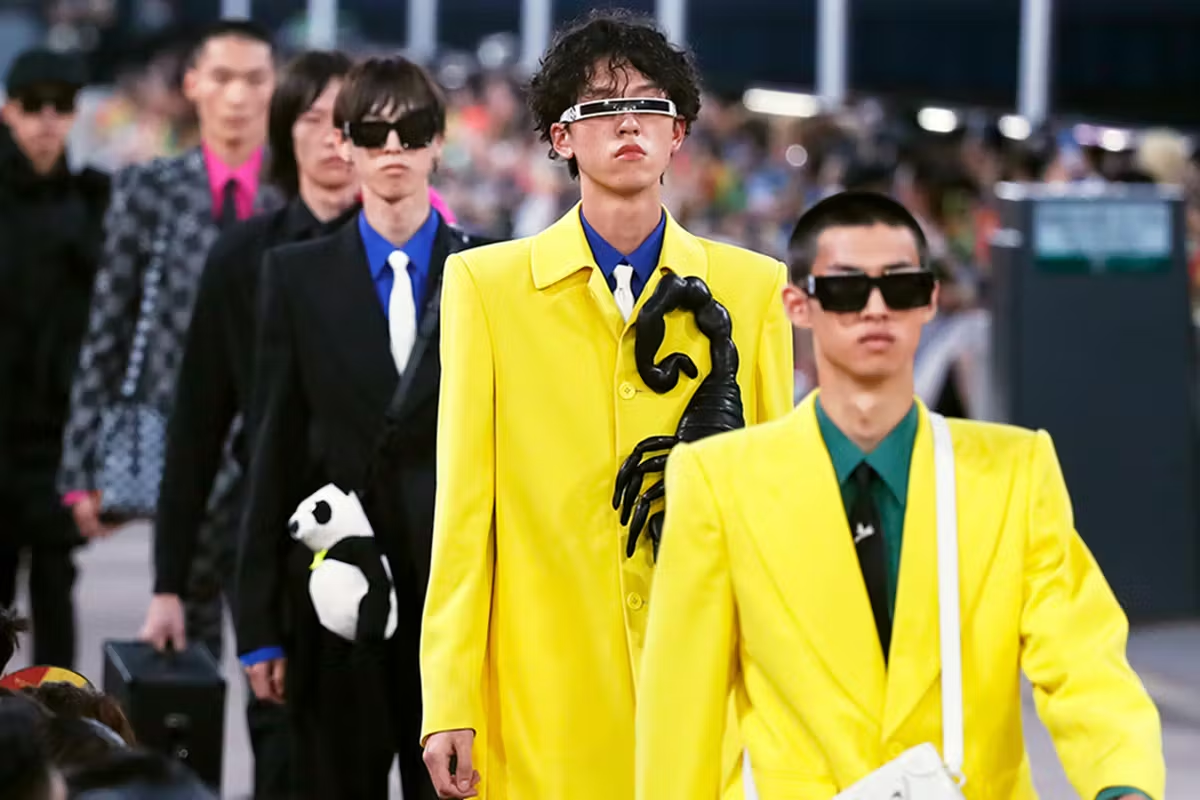
As commentary and official statements continue to fly around on the subject of Virgil Abloh's most recent Louis Vuitton menswear show in Shanghai - and the ire it drew from Antwerp Six designer Walter Van Beirendonck - it has become clear that the conversation is about much more than sewing stuffed animals to blazers. Days after the show, Virgil godfather Kanye fired back at Van Beirendonck, making sure to splash some acid on the appropriation watchdog Diet Prada in the process - and, a couple days after that, released his own bizarre presidential presidential campaign merch that was a direct logo jack of Vision Street Wear.
The reality is, this topic has become such a big conversation because of our collective fascination with the idea of "copying," and what originality itself even means in our time. We love to be able to call people out. We love to avenge underdogs that get copied. And we love to mourn a non-existent past where everything was a lot more "original." But, for myself personally, watching this conversation unfold as a student of cultural theory ( and someone who has spent a bizarre amount of time talking to and about Virgil Abloh), there are six fundamental ideas and facts about this scenario that I feel urgently need to be spelled out to our readers.
Plus, I've never written a "fashion take" before, so it seemed like fun.

Getty Images / Victor VIRGILE 
Anyone who attends fashion shows knows that when the designer's name comes up in conversation with certain buyers, PR bosses, and other denizens of the front row, it tends to roll off the tongue uncomfortably - like he's the fashion week equivalent of Lord Voldemort. Why? Because for people who have been in the game for a long time, Abloh and the Tommy Ton photo cohort represent the demise of a time when fashion was created by a small enclave of (mostly white) "genius" designers, and presented at industry weeks to a small village of (mostly white) industry pals. And there are inherent winners and losers in this sea change. Which brings me to my next point...
Conservatism is a belief system that is defined by a desire to return to a mythical time when things were allegedly better, simpler, and more pure. And, in the case of both political conservatives and many Abloh critics, this bygone "golden age" is one that had a lot less access for people of color.
In early 2017, Raf Simons, the newly minted Calvin Klein creative director, did an interview with GQ in which he singled out Virgil as being nice, but uniquely unoriginal as a designer. At the time, rumors were swirling that Abloh was being vetted to become Riccardo Tisci's replacement at Givenchy, and industry Whatsapp groups buzzed loudly about whether Raf's words were part of a coordinated attempt to discredit the Off-White designer. And while I won't take a Glenn Beck chalkboard out and start drawing a Da Vinci code diagram on that subject (also, the GQ interview took place before the Tisci announcement), there was definitely something strange about the comment. To start, it was in response to a question about what designers inspired Simons, to which he answered "Not Off-White," not bothering to even refer to Abloh by name.
It makes no sense to judge his work that way. Throughout his career, Abloh has been obsessively transparent about his design process, and the ways in which it is inspired by the readymade sculptural approach of Marcel Duchamp. He's even gone as far as to say, in an interview with me almost four years ago, that "Duchamp is my lawyer." And, while old school designers live denial of the fact that originality in the internet-era is a farcical notion, Abloh has founded his practice on making the postmodern nature of contemporary creativity an inherent part of his work - hence the "quotes" around things, and many other codes in his system. This way of operating also owes an inherent debt to Kanye West, Abloh's mentor and defender. To quote Michael Darling, the curator of Abloh's "Figures of Speech" exhibition at the MCA Chicago: "Virgil really designs on the cloud. He and his teams will be posting all kinds of different reference pictures. Then certain narratives or strong sets of imagery will emerge from that. I think you can trace that back to his work at DONDA, with Kanye and the team he had there. They would look at 50 different examples of a particular type of jacket, or shoe, or pant, or shirt, and then refine from there." None of this is a secret, and while incidents like this are bad and harder to explain, people who want to point a "gotcha!" finger at Abloh for using references just haven't done their homework.
Or if, as the designer himself claimed, he was actually referencing an older Vuitton collection instead. (See above.)
It is inherently misguided when discussions about the appropriation of ideas become the subject of legal speculation. Ideas and thoughts aren't intellectual property - and those who try to police them in such a way expose their own authoritarian thinking. Trying to talk about this menswear show using a legal framework is like visiting a neurosurgeon because you have a hangover.